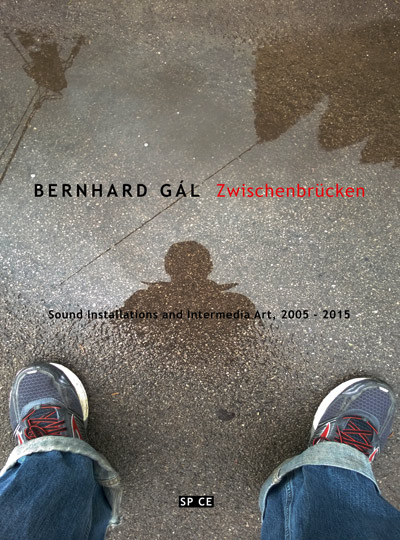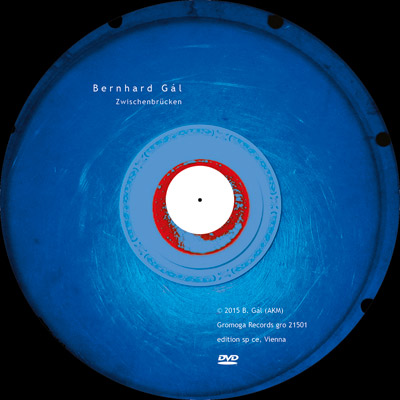
Gal Zwischenbrücken
| Book & DVD-Video, edition sp ce / Gromoga Records,
Austria, 2015 [ containing 144 pages and abundant colour photography, plus 4 hours of audio / video materials ] |
||
|
Zwischenbrücken
is a follow-up to the catalogue book ‘Installations’ (Kehrer 2005) and presents a
comprehensive
overview of Bernhard Gál’s artistic output since 2005.
The book is accompanied
by a DVD-Video containing audio and video documentation. |
|
Gal
Zwischenbrücken |
|
|||
|
Book & DVD-Video, edition sp ce / Gromoga, Austria, 2015
edition sp ce ISBN 978-3-903089-00-6 / Gromoga gro 21501 |
 |
|||
Das himmlische Kind |
Zürich, 2015 |
video excerpt
|
|
|
|
Credits Thanks to: Belma Bešlić-Gál, Marko Ciciliani, Martin Gál, Stefan Fricke, Nina Haider, Klaus Kehrer, Yumi Kori, Werner Korn, Markus Lidauer, Patrick McGinley, Manfred Meisterl Texts:
Bernhard Gál, Yumi Kori |
English-language editing:
Patrick McGinley |
Design and production:
edition sp ce, Vienna / Bernhard Gál |
Editor:
Bernhard Gál |
|
Zwischenbrücken |
reviews | |
|
|
||
BERNHARD GÁL Viele Klangkünstlerinnen und Klangkünstler sind deshalb bemüht, angemessene Formen der Dokumentation zu entwickeln–fast scheint es, als würden diese zum Bestandteil der Arbeiten selbst. Der österreichische Komponist, Klangkünstler und Musikwissenschaftler Bernhard Gál stellt mit Zwischenbrücken. Sound Installations and Intermedia Art eine Reihe seiner Klanginstallationen aus den Jahren 2005–2015 in einem reich bebilderten Buch vor, dem eine DVD mit Klangmitschnitten und Filmaufnahmen beigegeben ist. Dabei bemerkt er selbst in seiner Einführung, dass es sich bei dem Band nicht um einen Katalog im klassischen Sinn handelt. Es geht ihm mehr darum, seine eigenen Arbeiten in einer sehr persönlichen Weise zu reflektieren und Hintergrundinformationen zu den Entstehungsprozessen mitzuteilen – von der initialen Idee bis zur eigentlichen Realisierung. Die Beschreibungen sind stets gleich aufgebaut. Zunächst werden die Arbeit und die ihr zugrunde liegenden Ideen in einem knappen Text vorgestellt, mit der genauen Angabe von Titel, technischem Setting, Ort, Jahr und Auftraggeber. Es folgen großformatige Abbildungen, an die sich – nochmals (kleiner) bebilderte– Ausführungen zur Entstehung der Arbeit anschließen, die sich z.B. auf den spezifischen Ort, technische Fragestellungen oder besondere Probleme, die sich bei der Umsetzung ergaben, beziehen. Dem Leser erschließen sich die Werke so bereits durch das Buch aus verschiedenen Perspektiven. Ergänzt werden diese in der beiliegenden DVD durch Audiofiles und Filme, die vom Künstler selbst minutiös durchgestaltet wurden. Gerade die filmischen Aufnahmen verlangen durch die Schnitte und ihr Timing, die Wahl der Bildausschnitte usw. viele Entscheidungen und werden so selbst zu künstlerischen Arbeiten. Zumindest bieten sie dem Betrachter Impressionen der vorgestellten Arbeiten aus der subjektiven Sicht des Künstlers selbst. Viele der vorgestellten Installationen sind ortsspezifisch und beziehen sich auf Stadträume in Zürich, Košice, Donaueschingen u.a. Die filmische Bearbeitung lässt immer auch etwas von der Art der Verbindung zu den jeweiligen Orten erkennen, denn sie muss filmisch vom Künstler selbst hergestellt werden. Unbedingt erwähnenswert ist zu dem die Zusammenarbeit Gáls mit der japanischen Künstlerin und Architektin Yumi Kori, die in dem Band mit mehreren Arbeiten ebenfalls dokumentiert wird. Ein kleiner autobiografischer Essay, in dem die Zusammenarbeit mit Yumi Kori im Zentrum steht, rundet den gelungenen Band ab. [Marion Saxer, Neue Zeitschrift für Musik, Germany, 07/2016] |
|
|
|
||
Die Produktionen von Bernhard Gál habe ich schon früh wie zufällig entdeckt. Frank Hilberg hatte die ersten vier CDs aus Kyra Stratmanns Label Because Tomorrow Comes positiv in der ZEIT rezensiert. Dazu gehörte Gáls Soundwalk über den Nachtmarkt in Taipeh, ohne Nachbearbeitung, in realtime wie erlebt. 'Tong-Hua Yie-Shi', schon der Titel ist Klang. Später besuchte uns der Künstler im WDR-Studio für Klangdesign und erzählte vom Oral History -Projekt Austrian Heritage Collection am Leo Baeck Institut in New York und ersten Installationen. Viel später habe ich von seinem inter-universitärem Doktoratsstudium zwischen Mozarteum und der Universität Salzburg gelesen: ein Projekt, in einer Gruppe von DoktorandInnen, wo Gál über Raum- und Öffentlichkeitsaspekte von Klanginstallationen forscht. Jetzt erhielt ich von ihm eine reich bebilderte Publikation mit DVD zu Installationen, Performances und intermedialen Projekten aus den letzten zehn Jahren, mit Dialogpartnern aus vielen Kulturen. Ich dachte an den Slogan eines anderen Wieners, Friedrich Gulda, der vor Jahrzehnten eine 10er LP-Box herausgab mit Rollen als Klassiker, Bänkelsänger und Jazzer Midlife Harvest. Gáls intermediales Buch wirkt ähnlich; durch auto-ethnographische Erfahrungsberichte und den Einblick in weniger bekannte Stücke. Diese Sammlung von Arbeiten aus Klang, Zeit, Raum und Bewegtbild nennt er Zwischenbrücken und basiert auf einer weltweiten Kooperation zwischen Kunst, Wissenschaft und Kultur. Bodenständig verweist dies aber auch auf ein Wiener Viertel, nicht weit von da, wo der Klangkünstler herkommt. Ähnlich wirken seine Installationen und Performances miteinander verbunden, als ob sie benachbart sind, hinüberrufend in verwandte Formen. So weit der Kosmos von Gáls Arbeit ist, so zugänglich ist sie für Hörer. Alsógál (2014 in Budapest) zum Beispiel ist ein Netz von Elementen im Unterbewussten. In Schichten wird ein mythischer Vogel beschworen, der Alltagsgegenstand eines Wasserkessels, ja einer Wasserkultur mit chinesisch-instrumentaler Anspielung, im Kontrast zu realen Soundscapes von São Paulo und aus Salzburg. Die zwei Performances Klangschatten richten sich an ein jüngeres Publikum, sind ein Mix aus akustischen Instrumente aus China und Österreich, mit ‚elektroakustischen Schatten‘. Dem antworten mit kompaktem Volumen die farbig inszenierten Telefonzellen von Košice (solo, 2012); aber auch Klangzellen mit Texten in anderen Sprachen oder die Klangbojen im Wasser der Brigach von Donaueschingen (2007). An weiteren Orten begegnen sich große Räume, wie in einer von Belma Bešlić-Gál programmierten Planetariumsprojektion (Sterngucker, 2011) aus Myriaden von Einzelbildern. Ihre eigenen Arbeiten als Komponistin sind demnächst auch in einer CD-Produktion zu hören. Die Texturen, Hörfelder aus gefundenen Klängen zu Bildern von Wasser, Sand oder Geräuschen der Medien, wurden an mehreren Klangorten immer wieder neu installiert. Die Stromlinien wirken dagegen als akustische Interpretation von visuellen Mustern, das Konzept und die Erscheinungsweise werden sich ähnlich. Airport in Berlin von 2006 schließlich ist ein ‚Hafen der Klänge‘, über 12 Tonkanäle im Eingangsbereich des Musikinstrumenten-Museums. Eine besondere Bedeutung haben schließlich die Audio-Architektur-Installationen mit Yumi Kori, schon weil sie seit 1997 in immer neuen Variationen umgesetzt sind. Die Künstlerin wirkt von ihrer Biographie und Eigenart her wie ein Alter Ego Gáls; sie haben zusammen in Japan, USA, São Paulo und Berlin gearbeitet. Gerade solche Übergänge zwischen Künsten und Künstlern sind ein besonderes Merkmal von Gáls Arbeiten. Arrangements werden dabei anteilig oder komplett überarbeitet, als ‚Transformation räumlicher Erfahrung durch Klang und Licht‘. So verbindet sich in Defragmentation die Raumgestalt von Hörbarem in der New Yorker Galerie hin zur audio-visuellen Dimension von Acrylsäulen und transparenten Ballons in der Minoritenkirche von Krems. Der Aufenthalt in New York, die Arbeit in der Austrian Heritage Collection und die Begegnung mit Yumi Kori vertiefen also seit 1997 Gáls Katalyse von künstlerischem Wachstum generell und auch familiär. — eben wie eine Art Midlife Harvest. [Hans-Ulrich Werner, Positionen, Germany, 02/2016] |
||
BERNARD GAL - ZWISCHENBRÜCKEN (DVD/book by Edition SP CE/Gromoga Records) A good friend of mine always says: "get out of this silly business of records nobody wants to buy and get into art installations; that's where the money is". Maybe that's what Bernard Gal thought? He's been into the creation of multi-media installations for a long time now and with 'Zwischenbrücken' he releases his second book about his work in this directions. First time it came with a CD, this time it is a DVD, with close to two hours of music and two hours of films. This is (only?) his eleventh release, so he's not really into the silly business of CD releases I should think. His installations are presented all over the world, not just Western countries but also in Oman and Tunisia. Some of these installations are site-specific, while others can be shown in various places. In other pieces it's all about theatrical aspects of his work, and he uses players of instruments in his pieces. Light plays a big role in many of his pieces. In 'Solo' for instance he has four old telephone boots with various lights, which have music and one notices the city from a different colour. Shadow play with real musicians is also a common place. In this document we find snapshots of all of these from the last ten years. Most of them are represented by both audio and video and usually last somewhere between five and ten minutes. That perhaps has a bit of a snapshot idea to it, which is a pity. For some of these pieces I wouldn't mind to hear a longer version, whereas others didn't interest me that much, such as 'Klangschatten', but as I'm not a child so I am also not the intended audience. The book itself (144 pages, 200 photos, hardcover) contains for every installation a description (which looks like it might not have been made by Gal, but by a third party), whereas Gal himself writes more personal observations about his pieces. It all looks great, if not a bit highbrow art like, but I guess that comes with the territory. As a pure music man I can look at this and be a bit envious: simple ideas are turned, apparently, easy into great visual and musical pieces that work well - judging by the documentation. But for some of the music pieces I also had the idea that Gal is perhaps relying a bit too much on the use of laptop techniques and it seemed sometimes a bit too much time stretching and plug-ins making this into warm glitch-like music. Perhaps that is where the pure music man comes in, stripping away the rest and listening to the music? As a gesamtkunstwerk however I would say Bernard Gal's work is all top-notch. Hi Frans! First of all, I appreciate your rather elaborate review, knowing well that it is not exactly your cup of tea!
Let me just add a few corrections and comments: |
|
|
|
||
'monumentale' |
||
|
|
|
|
|
|
|